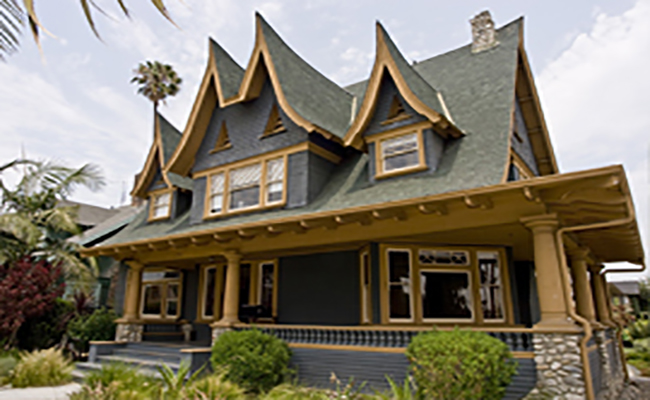
The fully-restored South Seas House | www.laparks.org
On the corner of Arlington and 24th Street in West Adams stands a house adorned with Tiki-style window gables whose 112-year history is even more colorful than its quirky exterior.
When its original owner died in 1922, the South Seas House began to deteriorate. Soon it was was abandoned, then occupied by vandals and squatters, and eventually taken over by the City of Los Angeles. At its bleakest point, as overgrown trees and bushes swallowed an uninhabitable interior cluttered with debris, the community stepped in and adopted the home as its own.
Today, the South Seas House – so named for its Polynesian architectural flourishes – is a city-run community center offering afterschool programs, senior classes and a summer camp, among other activities.
It’s hard to pinpoint exactly why a grassroots effort to save the South Seas House started, but what’s beyond dispute is that by the early ‘90s, the property was on the verge of being torn down. Then the City of Los Angeles transferred ownership to the Department of Recreation and Parks for, quite literally, nothing.
“It was transferred to them for zero dollars, which was fairly offensive to everyone in the community,” said Laura Meyers, who helped form the South Seas House Action Committee.
The Department of Recreation and Parks was interested in expanding a local park at the expense of the house, which didn’t sit well with members of the community.
“We ended up having quite a few community meetings so we could build community consensus,” Meyers said. The group ended up agreeing to try to create a youth center with job training and recreation programs.
The rebuilding of the South Seas House became politicized—City Council members got involved, and hundreds of people in nearby neighborhoods raised money for its renovation. Some, like the now-deceased John Deaven, took it upon themselves to raise awareness about the project. Meyers said he put up signs saying “Save our South Seas House,” replacing them “day after day after day” when they were taken down.
The community accumulated $18,000, at which point the City of Los Angeles pledged close to $1.7 million to fully fund the project. Local architect Michele McDonough was hired to oversee the rebuilding process in 2000, which she was happy to do. “I live in the neighborhood, and like all the neighbors, I was constantly driving by it,” McDonough said. “I just thought it was a wonderful house and was really upset that it was being permitted to fall apart the way it was.”
Eventually, after an arduous restoration process that took nearly 15 years in total, the South Seas House re-opened in 2003, becoming a hub of activity for the same people who saved it.
The original design by Joseph Dupuy, an orchestral music patron who was the first to live in the house, served as inspiration.
Scroll over the image below to see how the building was restored.
“It was a great feeling of joy, achievement, relief and pride that we had come together as a community to get this done,” McDonough said.
At the grand re-opening in 2003, the community’s attention turned to the adjacent Benny H. Potter Park, which was a popular hangout for local gangs and drug dealers. Guy Leemhuis, then the neighborhood council president, pledged to read a book aloud for an hour a week at the park, and urged his fellow community members to also get engaged. Eventually, a new basketball court, playground area, and other amenities were added.
“I think that after the house was restored, the rest of the park followed,” said Carlton Stubbs, who served as facility manager for the South Seas House from 2003 to 2013. “It became a hub for the community and it absolutely changed over the course of the years that I was there. I saw a lot more families coming to the park, less gang activity, so it really did change the face of that community and that park.”
Stubbs organized community events for children, teens and seniors, a tradition that continues today under new Facility Manager Marie Tropet. The house is also equipped with 17 computers, free for anyone to use to apply for jobs or print out documents.
Stubbs said he has witnessed positive effects on youth in the area.
“For summer camp, we had maybe anywhere from 40 to 50 kids there over the course of 10 weeks,” Stubbs said. “So we got a lot of kids from the community, and a lot of those kids sort of grew up there at the park.”
Many of the kids he knew as 12 and 13-year-old volunteers are now staff members – college students seeking professions in recreation programming.
Stubbs isn’t the only one who looks back on the history of the South Seas House with fond memories. Meyers has a theory about what motivated such a strong outpouring of support from the community.
“It was not a good time in Los Angeles,” said Meyers, describing the effects of the L.A. Riots, the Northridge earthquake and the economic recession. She came to see rescuing the house as a way to rescue the neighborhood.
“It became kind of a symbol of a neighborhood out of the ashes, not just a house out of the ashes,” she recalled. “And I think we succeeded.”
This article was originally published on Stories Between the Stops.
Like Intersections on Facebook, follow us on Twitter and sign up for the Newsletter to stay in the loop on news and views from South L.A.
















Speak Your Mind